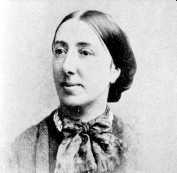Eleanor Anne Ormerod
| Eleanor Anne Ormerod | |
|---|---|
 | |
| Born |
11 May 1828 Sedbury Park, Gloucestershire, England |
| Died |
19 July 1901 (aged 73) St Albans, Hertfordshire, England |
| Nationality | British |
| Fields | entomology, agriculture |
| Institutions | Royal Agricultural College |
Eleanor Anne Ormerod (11 May 1828 – 19 July 1901) was an English entomologist. She was a daughter of George Ormerod, F.R.S., author of The History of Cheshire, and was born at Sedbury Park, Gloucestershire. From early childhood insects were her interest and she had great opportunities to study them in the large estate where she grew up. She studied agriculture in general and became a local authority on it. When, in 1868, the Royal Horticultural Society began forming a collection of insect pests of the farm for practical purposes, Ormerod contributed greatly to it, and was awarded the Flora medal of the society.[1]
In 1877 she published a pamphlet, Notes for Observations on Injurious Insects, which was distributed to interested persons, who in turn sent in the results of their researches, resulting in a series of Annual Series of Reports on Injurious Insects and Farm Pests. In 1881 Ormerod published a special report on the turnip-fly, and in 1882 was appointed consulting entomologist to the Royal Agricultural Society, a post she held until 1892. For several years she was lecturer on scientific entomology at the Royal Agricultural College, Cirencester.[1]
.jpg)
Her fame was not confined to England; she received silver and gold medals from the University of Moscow for her models of insects injurious to plants, and her treatise on The Injurious Insects of South Africa showed how wide was her range. In 1899 she received a silver medal from the Société nationale d'acclimatation de France.
Her works on natural history were widely cited and she undertook brave experiments:
Miss Ormerod, to personally test the effect, pressed part of the back and tail of a live Crested Newt between the teeth. "The first effect was a bitter astringent feeling in the mouth, with irritation of the upper part of the throat, numbing of the teeth more immediately holding the animal, and in about a minute from the first touch of the newt a strong flow of saliva. This was accompanied by much foam and violent spasmodic action,approaching convulsions, but entirely confined to the mouth itself. The experiment was immediately followed by headache lasting for some hours, general discomfort of the system, and half an hour after by slight shivering fits."
Among other works are the Cobden Journals, Manual of Injurious Insects, and Handbook of Insects injurious to Orchard and Bush Fruits. Almost the last honour which fell to her was the honorary degree of LL.D. of Edinburgh University - a unique distinction, for she was the first woman upon whom the university had conferred this degree. The dean of the legal faculty summarised Ormerod's contributions:
The pre-eminent position which Miss Ormerod holds in the world of science is the reward of patient study and unwearying observation. Her investigations have been chiefly directed towards the discovery of methods for the prevention of the ravages of those insects which are injurious to orchard, field and forest. Her labours have been crowned with such success that she is entitled to be hailed the protectress of agriculture and the fruits of the earth - a beneficent Demeter of the 19th century.[1]
She was also the first women to be honored with a fellowship in the Meteorological Society (1878).
On the death of her father she and her sisters moved to Torquay but then relocated to Spring Grove, Isleworth to be near to Kew Gardens where she had close friends in Sir Joseph and Lady Hooker, the garden's director.[1]
In 1887 she moved to Torrington House, 47 Holywell Hill, St Albans, Hertfordshire with her sister Georgiana Elizabeth Ormerod. She died there on 19 July 1901.[3] The building bears a plaque in her honour.
Partial list of publications
| Library resources about Eleanor Anne Ormerod |
| By Eleanor Anne Ormerod |
|---|
- Report of observations of attack of turnip fly in 1881 (1882) ;
- Manual of injurious insects with methods of prevention and remedy for their attacks to food crops, forest trees and fruit: to which is appended a short introduction to entomology (1890) ;
- Paris-green (or Emerald-green): its uses, and methods for its application, as a means of destruction of orchard moth caterpillars (1891)
- Handbook of insects injurious to orchards and bush fruits with means of prevention and remedy (1898)
- Flies injurious to stock : being life-histories and means of prevention of a few kinds commonly injurious, with special observations on ox warble or bot fly (1900)
References
- ↑ 1.0 1.1 1.2 1.3 Ormerod, Eleanor (1904). Wallace, Robert, ed. Eleanor Ormerod, Ll. D., economic entomologist : autobiography and correspondence. New York: E. P. Dutton and Company.
- ↑ Gadow, Hans 1909. Amphibia and Reptiles. Macmillan and Co. London.
- ↑ K., W. F. (1 August 1901). "Miss Eleanor A. Ormerod.". Nature, Obituary 64 (1657): 330–330. doi:10.1038/064330a0.
 This article incorporates text from a publication now in the public domain: Chisholm, Hugh, ed. (1911). "Ormerod, Eleanor A.". Encyclopædia Britannica (11th ed.). Cambridge University Press.
This article incorporates text from a publication now in the public domain: Chisholm, Hugh, ed. (1911). "Ormerod, Eleanor A.". Encyclopædia Britannica (11th ed.). Cambridge University Press.
External links
- Brief biography published in the New Scientist (Vol 172 Issue 2316) in 2001
- Eleanor A. Ormerod, The Online Books Page, University of Pennsylvania
|